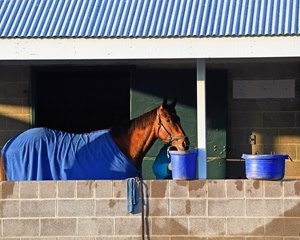Panel Outlines Worker Shortages Under New Standards


Trainer Rick Violette, participating in a law conference panel Aug. 7 in Saratoga Springs, N.Y., said immigration policies put in place by President Trump are leading to labor shortages on the backstretch.
Violette was one of the panelists discussing immigration worker issues Tuesday at the 18th Saratoga Institute on Equine, Racing, and Gaming Law Conference in Saratoga Springs, N.Y. The conference is presented by the Government Law Center at Albany Law School.
Violette said the Trump administration has put rules in place and made decisions that have greatly reduced the availability of legal immigrant workers, who have provided needed labor for the industry through seasonal work visas. One administration decision that bothered Violette in particular was only allowing less than 24% of the seasonal visas that could have been made available.
"This administration has built in obstacles to hiring seasonal workers," Violette said. "They eliminated the return exemption, they diminished availability—the insult of offering only an additional 15,000 visas when 63,000 were available—they're trying to make it as difficult and as economically unreasonable as possible to hire legal employees. It's a disaster out there."
Andrew Ayers, an attorney who has served as the director of the Government Law Center and visiting assistant professor at Albany Law School, moderated the immigration discussion at the conference, which this year was reduced from two days to one. The panel focused on challenges faced by the racing industry in light of changes to immigration policy instituted by the Trump administration.
The panel outlined how most non-U.S. workers in the racing industry hold H-2B visas, which permit seasonal work and are valid for up to 10 months. There are 66,000 visas available annually, with half approved in April and half in October. Other industries that make use of this type of visa are agriculture, landscaping, and hospitality.
Earlier this year, Congress approved a one-time increase of 63,000 additional visas this year, but the executive branch's Department of Labor and United States Citizenship and Immigration Services made available only an additional 15,000.
"In May," said Leonard D'Arrigo, a partner and co-chair of the Immigration Practice Group at Whiteman Osterman and Hanna LLP, "the Department of Labor received 142,000 applications for 33,000 visas."
D'Arrigo estimated the cost of each visa at $10,000 per employee, paid by the trainer, and said the reduction in the number of visas has resulted in an employment shortage in a variety of industries, including amusement parks.
"There are fewer students working in the summer," he said. "There really is a need (for immigrant labor)."
Contributing to the problem is the elimination of a process that made it easier to reinstate a returning worker. Formerly, an employee that had worked in the U.S. under an H-2B visa in at least one of three prior fiscal years would not count against the annual visa cap. That is no longer the case.
Both D'Arrigo and Violette addressed the contention that better pay and working conditions would help eliminate the need for migrant workers by appealing to local U.S. citizens. According to D'Arrigo, the prevailing wage requirements of the H-2B visa in fact makes hiring immigrants more expensive than hiring local workers, because not only is the wage requirement higher than the U.S. minimum wage, but if there is one employee working on an H-2B visa, all employees have to be paid at that rate.
At Saratoga Race Course, he said, the current prevailing wage for an H-2B worker is $11.84 an hour for grooms for up to 40 hours, after which the groom would earn time-and-a-half.
"It wouldn't make a bit of difference if we paid $15 an hour," Violette said. "We would not attract local workers. People are put off by the early hours, the mucking, the working in all kinds of weather."
In New York, he said, grooms commonly earn $500 a week plus bonuses from stakes races. After Violette's Diversify won the $1.2 million Whitney Stakes (G1) last weekend, he said the horse's groom earned a $6,500 bonus. Many grooms also are provided housing at the tracks.
"It's a 'total myth' that immigrant workers displace U.S. workers in racing," Violette said. "If people do respond to ads placed locally, they last about two days."
